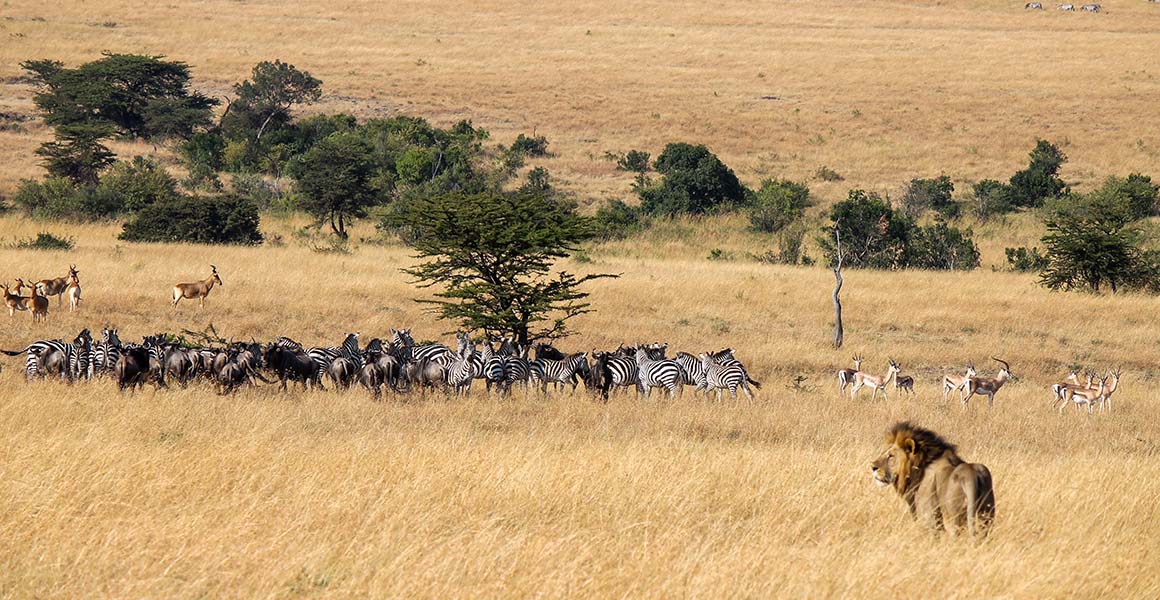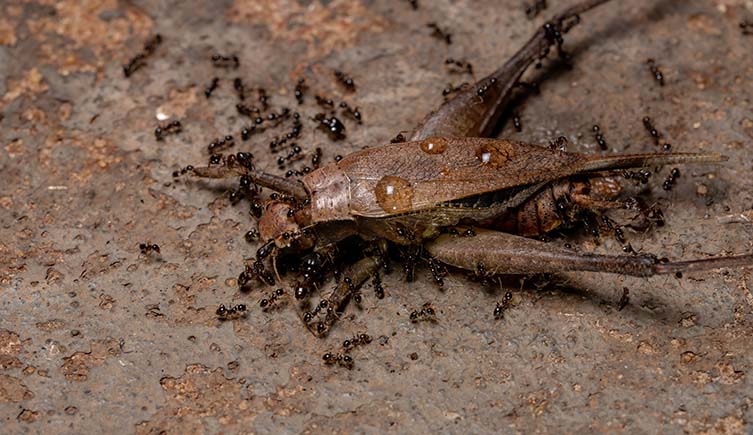Invasive ants are affecting how lions hunt.
The insect invasion has led to the loss of cover for lions to ambush zebra from and forcing them to target buffalo instead.

With fewer acacia trees left on the savannah, lions have less cover to ambush prey from. Image © Robin Nieuwenkamp/Shutterstock.
Invasive ants are affecting how lions hunt.
The insect invasion has led to the loss of cover for lions to ambush zebra from and forcing them to target buffalo instead.
An army of big-headed ants is changing the food chains of the savannah.
Though they’re little, these ants are fierce. Their arrival in parts of Kenya has decimated populations of local ants which usually live in and protect the whistling-thorn tree. Without the insects’ protection, these trees are increasingly being eaten by elephants, providing less shelter for a range of species.
One animal this has had a particular impact on is the African lion. These big cats usually use of the shelter of trees to sneak up on zebras. But with fewer trees, this strategy becomes increasingly risky.
Fortunately for the lions, their populations haven’t suffered as a result of the changes – thought to be because they’re now eating more buffalo instead.
Co-author Professor Todd Palmer, from the University of Florida, says, ‘These tiny invaders are cryptically pulling on the ties that bind an African ecosystem together, determining who is eaten and where.’
‘While critters like lions tend to find solutions to the problems they face, we don’t yet know what could result from the switch from zebra to buffalo. We are keenly interested in following up on this story.’
The findings of the study were published in the journal Science.

Big-headed ants attack other small animals, and can wipe out native acacia ant colonies. Image © Vinicius R. Souza/Shutterstock.
The whistling-thorn tree is a common sight on the plains of the east African savannah. A type of acacia, it gets its name from the noise the wind makes as it blows across its distinctive, bulbous spines.
Each tree is home to one of four different species of acacia ant, which shelter inside the spines and drink nectar from the tree. In return, the insects will swarm and attack herbivores like elephants, giraffe or rhino which try to eat their home.
This mutually beneficial relationship, known as a symbiosis, has allowed the trees and the ants to prosper. Not only that, but the tree also supports a variety of birds such as the superb starling, which lays its eggs in the tree to protect them from predators.
But the arrival of the big-headed ants has threatened these relationships. Originating in southern Africa, the ants are considered one of the world’s worst invasive species as they’re now found all over the globe.
‘We often find it’s the little things that rule the world,’ Todd says. ‘These tiny invasive ants showed up in Kenya maybe 15 years ago, and none of us noticed because they aren’t aggressive toward big critters, including people. We now see they are transforming landscapes in very subtle ways but with devastating effects.’
Big-headed ants are voracious predators, catching and killing a wide variety of animals from insects to small birds. When they encounter species like the acacia ant, they will kill any adults they come across and feed on their eggs and young.
But the big-headed ants don’t have a symbiotic relationship with the whistling-thorn tree. Instead, they leave the tree without its insect defenders.
Without the ants to protect them, previous research estimates that the number of trees eaten by elephants increases by five to seven times, leading to reduced tree cover on the savannah. The researchers wanted to test exactly how this affected the relationships of other predators and prey living in Kenya.

The arrival of the ants causes a cascade of changes which eventually lead to the loss of the whistling-thorn tree. Left image © Pat Milligan and right © Brandon Hays.
To see what impact the ants were having, researchers divided the study into two sections. First, the team divided the landscape of Laikipia county, Kenya, into equal sized plots of land. Half were within in an area already invaded by big-headed ants, while the other half were in areas free of the insects.
The plots were then further divided, with some fenced off to prevent large herbivores entering and the others left open. This allowed the researchers to see what impact the ants and the herbivores had separately and together on tree cover.
They found that in the unfenced areas invaded by ants, the visibility was almost three times greater because of elephants knocking over and consuming the whistling-thorn trees. In invaded areas where elephants were excluded the visibility was lower. This suggests that the ants alone were not responsible for the difference in tree cover.
The next part looked at impact this had on other animals, using a group of six lionesses. They discovered that in regions where ants were present, the visibility of the surrounding area increased by about 13 metres and zebra kills were around three times lower.
This created something of a puzzle – why had the number of lions stayed stable when they were catching fewer zebras?
It turned out that the lions were switching to alternative food sources, with around 42% of all kills in the ant-infested area now being buffalo. While it hasn’t yet been confirmed, this probably means the lions have had to change their behaviour, working together in larger groups to take down their new prey.
Though the lion, buffalo and zebra populations seem stable for now, the scientists have called for further research to find out more about the long-term consequences of the ants’ arrival in Kenya, and what can be done to stop them moving further across the country.

We're working towards a future where both people and the planet thrive.
Hear from scientists studying human impact and change in the natural world.
Don't miss a thing
Receive email updates about our news, science, exhibitions, events, products, services and fundraising activities. We may occasionally include third-party content from our corporate partners and other museums. We will not share your personal details with these third parties. You must be over the age of 13. Privacy notice.
Follow us on social media